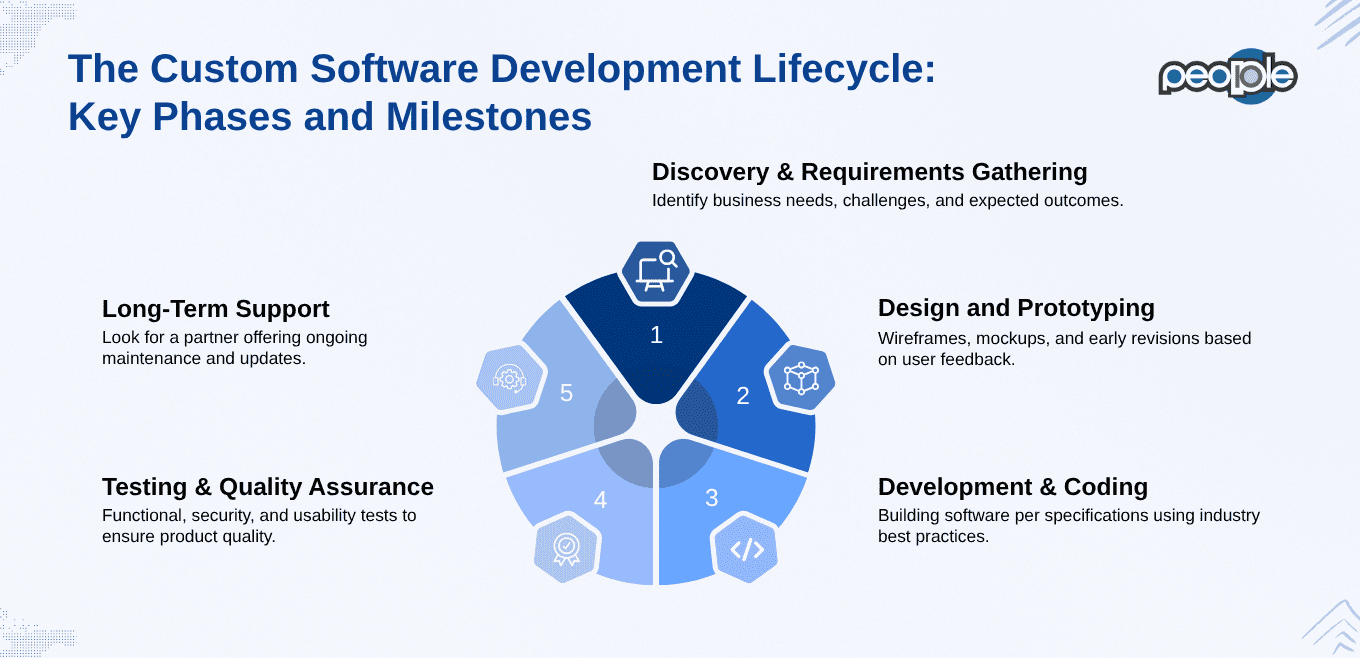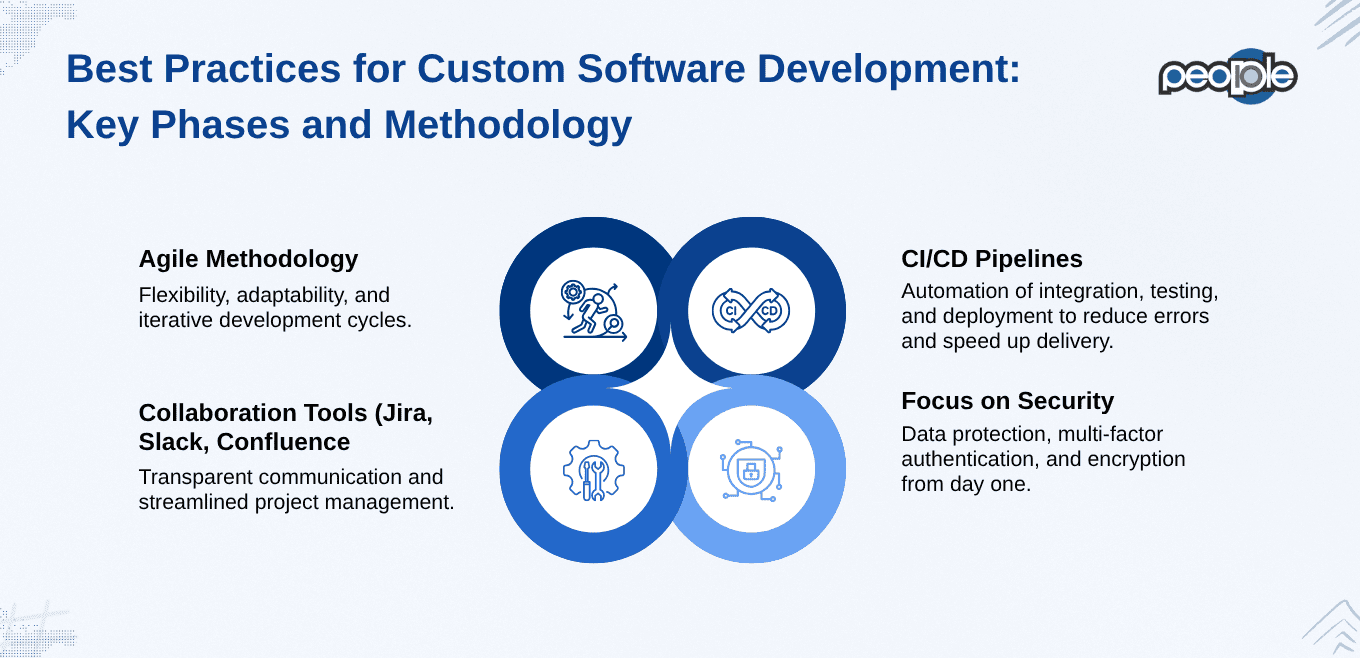Custom software development drives business growth by aligning technology with internal processes and strategic objectives. It improves operational efficiency through automation, reduced manual effort, and seamless system integration.
This approach provides greater control, scalability, and adaptability across business functions. CTOs and CIOs can leverage custom software to eliminate bottlenecks and enable faster, data-driven decision-making. Industries with strict compliance, real-time operations, or complex workflows often outgrow the limits of off-the-shelf solutions.
The global custom software development market is projected to grow from $43.16 billion in 2024 to $146.18 billion by 2030. It reflects a compound annual growth rate (CAGR) of 22.6%. This surge indicates a significant shift toward tailored software that addresses industry-specific demands. Additionally, it fuels long-term success.
In this article, we will examine how custom software development is essential for addressing core business challenges, providing flexible and long-term solutions. Additionally, we will discuss why it should be the strategic focus for technology leaders today.
What is Custom Software Development?
Custom software development is the process of designing and building software tailored to an organization’s specific needs.
Unlike generic off-the-shelf solutions, custom software is built to integrate seamlessly with an organization’s existing systems and workflows. It offers scalability and adaptability that off-the-shelf options cannot provide. Additionally, it ensures that your software evolves with your business needs over time.
Why Custom Software Over Off-the-Shelf Solutions?
Off-the-shelf software may appear to offer a quick and low-cost solution, but it often comes with significant drawbacks:
- Limited Functionality: Pre-packaged software often lacks features specifically tailored to your business requirements.
- Scalability Issues: As your business grows, these solutions may struggle to scale efficiently.
- Integration Barriers: Off-the-shelf solutions may not integrate seamlessly with existing systems, resulting in data silos and inefficiencies.
In contrast, custom software development offers businesses the flexibility to create solutions that meet specific needs and grow with the organization. By choosing custom software, businesses gain enhanced control, improved security, better integration, and more efficient operations.
Case Study: Transforming Flood Insurance with Real-Time Quotes and Automated Workflows
To modernize a traditionally underserved insurance segment, People10 built a cloud-native flood insurance platform with real-time quoting and parametric risk scoring. Agents now use a secure, multi-tenant portal with role-based dashboards and automated workflows. Homeowners receive quotes in under 60 seconds. The result: 2.3x higher quote-to-policy conversions, 90% faster quote generation, and 70% fewer manual steps.
Download the case study to explore how People10 accelerates digital transformation in complex insurance ecosystems.
It shows how a tailored solution outperforms legacy tools, proving the value of custom software over generic options.
These solutions also offer improved security and support. They are built specifically for the business, eliminating the risks associated with generic, one-size-fits-all software.
Organizations that implement custom software solutions have reported profit increases and higher customer acquisition rates attributed to personalized experiences.
The Custom Software Development Lifecycle

The custom software development lifecycle is a structured and iterative approach that ensures the software meets business needs. It also maintains the highest quality standards. Below are the key stages:
Discovery & Requirements Gathering
This phase is crucial for understanding the core business challenges and defining the scope of the project. A thorough discovery process allows teams to gather detailed requirements. It ensures that the software solution addresses the right problems from the beginning.
Design and Prototyping
Once the requirements are defined, the design phase begins. Here, wireframes and prototypes are developed to visualize how the software will function. The user experience and design decisions are made based on user feedback, allowing for early-stage revisions before the development process begins.
Development & Coding
The development phase involves coding the software according to the specifications outlined in the design phase. This stage typically follows agile methodologies, which ensure incremental progress and regular feedback loops.
Testing & Quality Assurance
Testing is critical to ensure the software works as intended. It includes various types of testing, such as functional, performance, security, and usability testing. This is done to ensure the software meets business objectives and quality standards.
Deployment & Maintenance
Once the software passes the testing phase, it is deployed into the production environment. Ongoing maintenance is required to resolve any post-launch issues, implement new features, and ensure the software evolves with business needs.
Key Technologies and Tools in Custom Software Development
Leveraging the right technologies and tools is essential for building scalable and efficient custom software solutions. Some of the key technologies include:
- Cloud Computing: Platforms like AWS, Microsoft Azure, and Google Cloud provide the infrastructure needed to support scalable applications.
- Microservices Architecture: This design approach allows businesses to build more scalable and maintainable applications by breaking down large systems into smaller, independent services.
- APIs: Custom software often relies on APIs to seamlessly integrate with other systems, enabling efficient data exchange and enhancing functionality.
- DevOps and Automation: Automating processes such as code deployment and testing ensures faster, more reliable releases.
- AI & Machine Learning: Integrating AI and ML into custom software can help businesses enhance user experiences and inform more informed decision-making processes.
Best Practices in Custom Software Development


To ensure the success of custom software development, following best practices is essential. These practices guide teams through the complexities of building scalable, efficient, and high-quality software solutions.
Agile Methodology for Flexibility and Speed
Agile development is widely recognized as the best practice for custom software projects due to its flexibility and ability to accommodate change.
By breaking down the development process into iterative cycles, teams can quickly adapt to evolving requirements. It allows faster releases and continuous feedback from stakeholders.
Using frameworks like Scrum or Kanban, Agile enables teams to focus on delivering incremental improvements. All while maintaining a high level of collaboration and communication throughout the project lifecycle.
Collaboration and Communication Between Teams
Effective communication between development teams, project managers, and stakeholders is crucial for the success of custom software projects. Regular meetings, clear documentation, and collaborative tools like Jira, Confluence, and Slack help keep everyone on the same page.
Continuous interaction ensures that project goals are well understood, and adjustments can be made as needed, preventing misunderstandings and misalignment.
Continuous Integration and Continuous Deployment (CI/CD)
CI/CD pipelines are integral to ensuring fast, reliable, and consistent releases. Automation of code integration, testing, and deployment minimizes the risk of human error. Additionally, it accelerates delivery times and allows for faster bug detection and resolution.
This approach helps maintain high-quality standards, reduces manual intervention, and increases overall development efficiency.
Focus on Security and Compliance
Security should be a primary concern throughout the software development lifecycle. Implementing strong encryption, multi-factor authentication, and regular security audits ensures that your software is protected from vulnerabilities.
Moreover, adhering to industry-specific compliance regulations, such as GDPR, HIPAA, or SOC 2, helps safeguard user data. It ensures that your software meets all required legal and regulatory standards.
Common Challenges in Custom Software Development
Custom software development offers immense potential to address unique business needs. But it also presents several challenges that must be overcome to ensure project success.
These challenges often arise from the inherent complexity of requirements, communication gaps, and external factors. They include time, budget constraints, and integration with legacy systems.
Here are some of the key challenges you should be prepared to face when embarking on custom software development.
Scope Creep and Managing Expectations
One of the most common and disruptive challenges in custom software development is scope creep. This occurs when the project’s requirements expand or change beyond the original scope without corresponding adjustments to the timeline or budget. Scope creep can lead to delays, increased costs, and reduced quality if not effectively managed.
To avoid this, set clear project goals from the start. Use strong change management to evaluate and approve scope changes with all stakeholders. Maintain regular communication, documentation, and checkpoints.
Balancing Time, Cost, and Quality
Balancing time, cost, and quality remains one of the most persistent challenges in custom software development. Stakeholders often face pressure to deliver software within strict deadlines and budgetary constraints. However, cutting corners to meet these constraints can negatively impact the final product’s quality.
Adopting Agile development practices is an effective way to manage this balance. By breaking the project into smaller, iterative cycles, teams can focus on delivering incremental value, allowing for continuous feedback and prioritization.
This approach ensures that time and cost constraints do not compromise quality. It helps maintain high standards of functionality, security, and performance throughout the development lifecycle.
Integration with Legacy Systems
Integrating new custom software with existing legacy systems is another challenge that organizations face during the development process. Legacy systems, often outdated or based on incompatible technologies, can make integration complex and time-consuming.
Successful integration requires careful planning, in-depth understanding of the legacy systems, and a thorough testing strategy. In many cases, legacy systems may need to be updated or even partially replaced to enable smooth integration with new software.
Despite the potential resource-intensive nature of this task, effective integration ensures seamless business operations. It also provides a scalable foundation for future software updates or expansions.
Post-Launch Maintenance and Support
The challenges do not end once the software is deployed. Ongoing maintenance and support are essential for addressing bugs. It also includes fixing security vulnerabilities and ensuring that the software remains up to date with the evolving business needs.
Neglecting post-launch maintenance can lead to software degradation, security threats, and user dissatisfaction.
A well-defined post-launch maintenance plan is crucial for ensuring the long-term success of the software. Additionally, customer feedback and performance metrics gathered post-launch provide valuable insights that can inform future updates and improvements.
How to Choose the Right Development Partner


Selecting the right development partner is one of the most critical decisions in custom software development. A suitable partner can help you navigate technical complexities, align with your business goals. Plus, it can ensure the final product meets your organization’s needs.
Here is how to evaluate potential partners effectively.
Evaluating Software Development Companies
When assessing software development companies, focus on their technical expertise, experience, and portfolio.
Look for a partner who has proven experience in delivering high-quality, scalable software solutions, especially in projects similar to yours.
It is also important to understand their development processes, team structure, and approach to project management. Request case studies or references from previous clients to gauge the reliability and performance of the company.
A strong portfolio and positive client feedback indicate a track record of success and a company capable of handling your project needs.
In-House vs. Outsourced Development
Choosing between in-house and outsourced development largely depends on your business needs, budget, and timeline. In-house development gives you more direct control over the project, allowing for better communication and coordination.
However, it requires substantial time and resources for recruitment, training, and managing the team.
On the other hand, outsourcing offers the advantage of accessing specialized talent without the overhead costs associated with full-time hires.
Experienced development agencies can provide a cost-effective solution, particularly if you need to scale quickly or lack specific expertise in-house.
When making this decision, evaluate the project’s complexity, your budget, and whether your internal resources can handle the development workload effectively.
Aligning Goals, Processes, and Communication
Successful software development partnerships are built on clear, consistent communication and mutual understanding. It is crucial that your development partner understands your business objectives and is aligned with your vision.
Ensure that there is a transparent agreement on project goals, timelines, and expectations from the outset.
Establishing clear milestones and regular check-ins is essential to monitor progress, track changes, and manage risks. Make sure the development team uses collaborative tools, such as Jira or Confluence, to facilitate seamless communication between all stakeholders.
This ensures that the development process runs smoothly and the final product aligns with your goals, minimizing misalignment or delays.
Conclusion: Custom Software Development is Essential for Business Growth
Custom software enables businesses to streamline operations, enhance flexibility, and stay ahead of competitors. Businesses can unlock the full potential of their custom software solutions by partnering with the right development team.
Custom software enhances integration, boosts security, and allows for rapid scaling to meet evolving demands. Unlike off-the-shelf solutions, it fosters innovation and enables unique customer experiences, setting your business apart in a competitive landscape.
Ready to build your custom solution?
At People10, we specialize in creating high-quality, scalable custom software solutions that drive growth and efficiency.
Author
Nandakumar excels in delivering diverse solutions from mobile apps to complex enterprise systems. At People10, he continues to drive success with a focus on customer satisfaction and innovative technology solutions.




